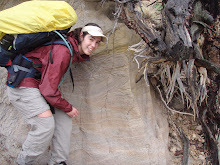Lake Ontario
I heard the second half of a great talk by Dr. Steve Chapra today. He created a model in the 70's that used population data and land use to infer and predict phosphorus levels in the Great Lakes through time. Basically, the pollution in the lakes was increasing exponentially, largely due to human waste and detergents. His model was used by the US and Canada to help develop levels of allowable phosphorus coming out of sewage treatment centers and in detergents. The model predicted a specific decline that would occur by the implementation of the proposed regulations. For the past 3 weeks, he has been entering in some data that was collected in the intervening years on phosphorus levels in the lakes to see if his model was accurate. He couldn't believe that data he was getting. The pollution in the lakes has regressed at similar rates to those predicted. However, Lake Ontario had the best rate. In fact, the phosphorus levels are much lower than they should be compared to the amount entering the lake (it's called the amount of loading). The rate is also very steady and does not have much variation at all (aka the dots fall along a curved path not around a curved path). As he was talking about this and how he is perplexed and can't publish data he can't believe he got, I was thinking that perhaps zebra mussels were the reason. Lo and behold, a couple minutes later he mentions that he thinks that zebra mussels may have something to due with the abhorrent values for Lake Ontario (as well as have some affect on the other lakes). This is brand new data that won't be published for at least a couple of years too. Yet, it seems that the efforts of those around Lake Ontario have helped clean up the lake a bit so that it is not eutrophic or in danger of being so...it's amazing, perplexingly, clear. I wonder if SUNY ESF (or as Matt, my advisor, says, "SUNY"...as if there aren't a couple dozen more SUNY schools) or Cornell or some school locally will be investigating why this phenomenon occurred. It's just so cool.
Earlier today, I meet with a lady down at St. Thomas Aquinas to fill out some paperwork for teaching religious ed (aka CCD). I'll teach 4/5th graders from 11:15-12:15 every Sunday and there are materials provided so I don't have to make up lesson plans...they come right out of a new packet every week that the students receive. I'm excited to be able to work with kids again as I always seem to miss it when I'm at school and around adult-type people all the time...even if we don't always act like adults. I already have a couple of ideas of integrating some other cultures (like Germany) into the class as well as stuff from World Youth Day. Since there is a large Hispanic community within the parish, which includes some of my students, I think it would also be neat to do some bi-lingual stuff so we can all learn a bit of Spanish along the way and make the Hispanic students feel more empowered and accepted...that's the goal at least.
Speaking of learning some Spanish, a professor at the university who teaches Spanish will be having informal Spanish lessons at the Newman Center on Thurdays starting soon. So I can learn some Spanish and not actually have to take a class...pretty sweet! :-)


0 Comments:
Post a Comment
<< Home